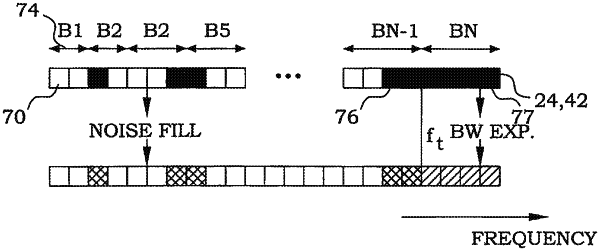| CPC G10L 19/028 (2013.01) [G10L 19/0204 (2013.01); G10L 19/032 (2013.01); G10L 21/038 (2013.01); G10L 19/035 (2013.01)] | 17 Claims |

|
1. A method for processing an audio signal, comprising:
obtaining a first set of quantized coefficients representing at least a portion of the audio signal, wherein each quantized coefficient included in the first set of quantized coefficients is in one frequency band that is included in an ordered set of frequency bands {B(1), . . . , B(N)}, where N>1, each of the frequency bands B(1) to B(N) comprising a plurality of frequencies between an upper frequency of the frequency band and a lower frequency of the frequency band;
determining a transition frequency, wherein the transition frequency divides the set of frequency bands into a first subset of frequency bands and a second subset of frequency bands;
filling holes in the first subset of frequency bands using a first algorithm; and
filling holes in the second subset of frequency bands using a second algorithm, wherein
determining the transition frequency comprises:
determining whether the number of quantized coefficient within band B(N) is greater than zero; and
if the number of quantized coefficient within band B(N) is greater than zero, then determining the transition frequency based on band B(N), otherwise determining the transition frequency based on a band closest in order to band B(N) that has at least one quantized coefficient.
|